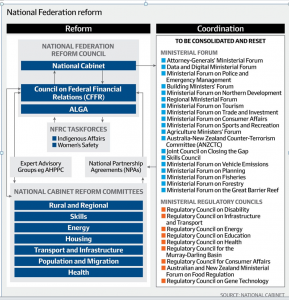As the Victorian Parliament’s Federal-State Relations Committee observed in 1998, Prime Minister Hawke expressed a commitment to improving intergovernmental decision-making, following a particularly acrimonious Financial Premiers Conference in June 1990.
The first step was to propose a number of procedural changes to the Premiers Conference itself, with the intention to reduce its ad hoc nature, and to allow consideration of options and greater preparation prior to the meetings, rather than jurisdictions receiving information literally the night before meetings, as happened on some occasions.
The COAG process then evolved to pursue the objectives of:
- the creation of a more integrated and cohesive single economic market;
- the provision of a more flexible and decentralised delivery system for economic and social programs;
- the enhancement of the ability of governments to make joint decisions; and
- the maintenance of a balance between competition and co-operation.
However, since then the COAG structure has ossified to the point where the structure is one ‘where good ideas go to die’.
Now that much of the initial disruption of COVID has died down and the ‘Team Australia’ approach commences to splinter it is important to see how the new structure will ordinarily operate.
As Colin Barnett, the former Premier of Western Australia said in a recent article:
Neither the COAG nor the National Cabinet hold any constitutional or legislative powers. They are simply a meeting of a prime minister in the state premiers. They are not a level of government, yet interest groups talk openly about lobbying them.
He also said:
My experience of the COAG was that the way it worked very much depended on the attitude of the prime minister of the day. I expect the national cabinet will be the same.
This is the new structure:

How ministers ‘can come together to solve issues without requiring bureaucratic structures’ is one of the matters to be considered by the COAG structure review referred to in a previous post.
The proposed new structure needs to be calibrated properly. As you can see from the graphic, there’s still a lot of moving parts, irrespective of whether a ‘consolidation and reset’ of ministerial councils and forums is actually achieved.
In our view, one thing that must change is the very bureaucratic process set out in the Handbook for COAG Council Secretariats – A best practice guide which significantly delegates significant powers (particularly the power to program agendas) to senior officers.
In our experience, it is this structure which gives rise to the inertia that doomed to the current COAG concept.
More generally, the questions that will need to be resolved include:
- Once the focus on jobs, jobs, jobs as a result of COVID dissipates, what is the precise mission statement of National Cabinet. Does it make ‘binding’ decisions that jurisdictions are supposed to implement or merely establish principles? Or is it just a glorified Premiers’ Conference of old? A statement of how the proposed structure will vary in practice from the pre 1990’s structure would be beneficial.
- What is the ‘mission statement’ of the National Cabinet Reform Committees and the ‘consolidated and reset’ Ministerial Forums? Will the Reform Committees really make decisions in a dynamic fashion for consideration by National Cabinet? Or will they merely revert to operating like the current COAG councils that exercise some limited statutory powers recognised by legislation?
- Do the reset councils or forums report to the Cabinet Reform Committees, or (as the diagram suggests) do they implement National Cabinet decisions? And if that’s the case, it suggests that some form of secretariat structure. Will something like the current COAG one simply be recreated?
- How is progress to be measured? A return to the COAG Reform Council concept?
Perhaps we will find out more once the Conran Review reports.
One final question – does the Council of Federal Financial Relations have too much power in the revised process?
This is something discussed in the final post of this series.
